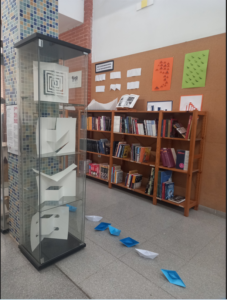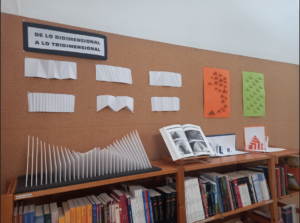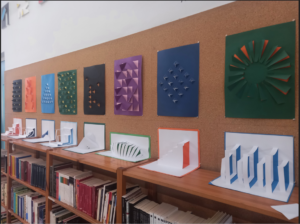Cuando hablamos de bidimensionalidad nos referimos a las dos dimensiones que determinan un trabajo artístico: longitud y anchura.
La bidimensionalidad es una creación humana, muchas veces podemos ver las cosas tridimensionales de una forma bidimensional, como en el caso de una pintura o una fotografía, por ejemplo.
La tridimensionalidad la notamos cuando hay además profundidad. Por lo tanto en una figura tridimensional están presentes las tres dimensiones: largo, ancho y profundo.
En esta exposición mostramos las distintas propuestas plásticas desarrolladas este trimestre. En ellas hemos trabajado el paso de lo bidimensional a lo tridimensional.
Las acciones llevadas a cabo para llegar a la apariencia tridimensional a partir de una superficie bidimensional han sido principalmente: cortes y dobleces.
La primera experiencia ha consistido en doblar simplemente una cartulina blanco para empezar a generar un juego volumétrico en el que la luz ha teñido el papel según la dirección en la que ha incidido sobre este.
La segunda experiencia ha sido introducir además de los dobleces, los cortes. En este trabajo hemos jugado con la repetición de figuras geométricas siguiendo ritmos y contrastes de color.
En la tercera propuesta hemos jugado con la técnica Pop-up, gracias a diferentes cortes y pliegues, hemos conseguido la tercera dimensión, proporcionando volumen a nuestros trabajos realizados con cartulina blanca sobre cartulina de color creando contraste.
Dimos un paso más en la cuarta propuesta creando esculturas blancas con cartoncillo siguiendo la misma técnica.
Finalmente y como última propuesta hemos realizado planos seriados en los que por medio de repetición de figuras con cambio de formas o direcciones hemos construido esculturas con diversos efectos visuales.



















